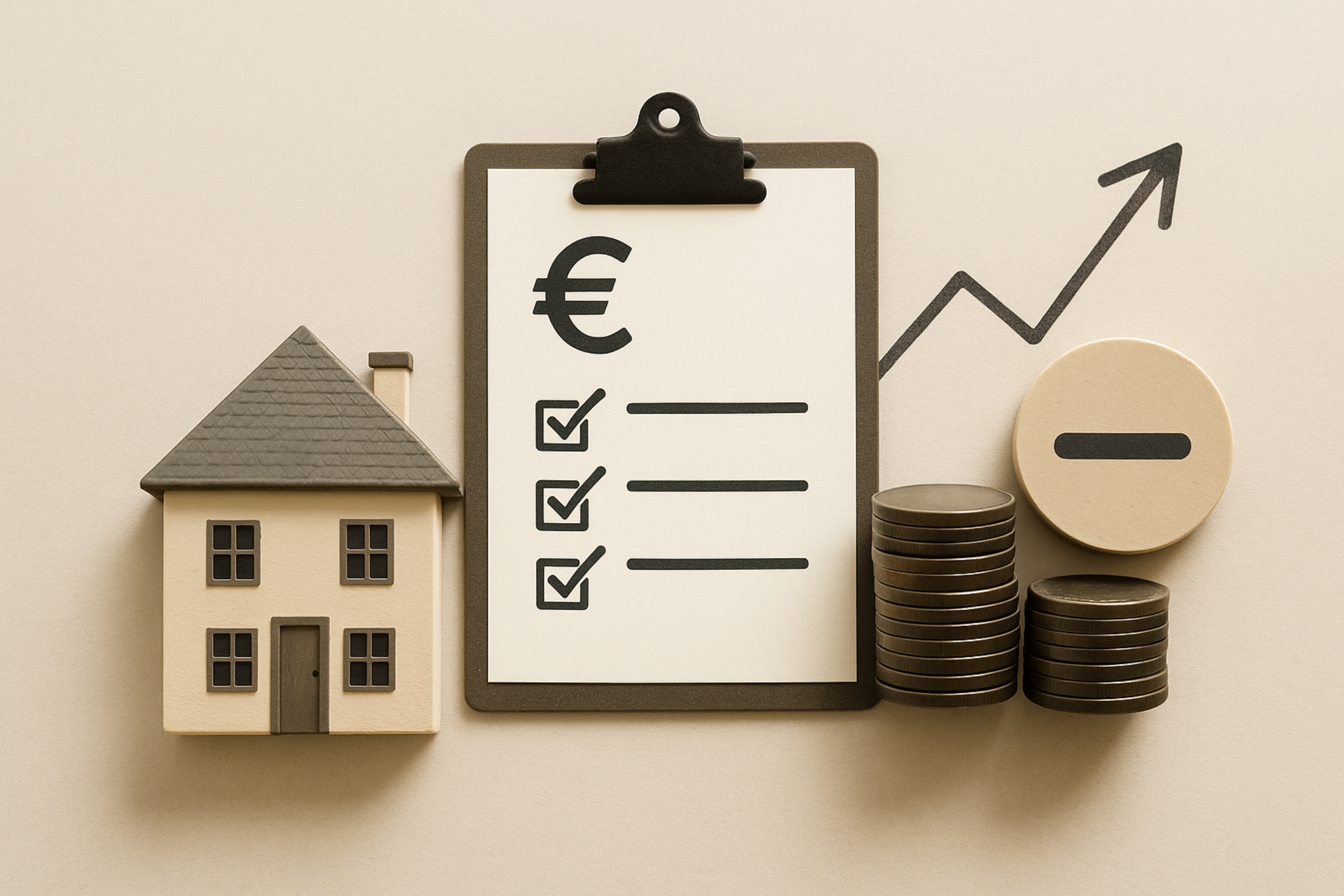1. The principe
According to article 167 bis of the French tax code (CGI), the transfer of a tax residence outside France results in the immediate imposition of income tax and social security contributions on unrealised capital gains on corporate rights, securities or rights, on claims arising from an earn-out clause and on deferred capital gains.
However, this system allows for the possibility of deferring payment and, under certain circumstances, to obtain a refund or reduction of tax.
The law sets the taxable event as the day before the taxpayer ceases to have unlimited tax liability in France.
2. The people affected
These are taxpayers who:
– have been tax resident in France for at least 6 of the 10 years preceding the transfer of their tax residence abroad;
– own, directly or indirectly with members of their tax household, corporate rights, securities or rights :
– representing at least 50% of a company’s profits on the date of the transfer of residence ;
– or have a total value of more than 800,000 euros on the same date.
All taxpayers, regardless of how long they have been resident in France, who transfer their tax residence outside France are subject to taxation on their capital gains placed under deferred taxation at the time of this transfer.
Furthermore, these deferred capital gains are taxable without any limitation in proportion to the percentage or value of the participation in the profits of the company concerned.
3. Affected securities and receivables
These are the corporate rights, securities, titles or rights mentioned in 1 i I of article 150-0 A of the CGI, i.e. in particular:
– transferable securities, corporate rights, bonds, etc;
– rights related to these securities, rights or titles such as usufruct or mere ownership;
– securities representing the same securities or rights, such as UCIs;
– claims for premiums;
– securities to which a tax deferral is attached.
4. Exempt securities
However, this does not apply to shares in a PEA, carried interest shares, shares in employee savings schemes or shares in companies or associations covered by articles 8 to 8b of the General Tax Code that are predominantly real estate in nature.
For transfers of tax residence outside France occurring after 1 January 2019, the exit tax regime explicitly applies to unrealised capital gains on shares in companies with a predominance of real estate assets subject to corporate income tax in accordance with the provisions of Article VIII, 4 of Article 167 bis of the CGI.
5. Tax base
Unrealised capital gains are determined by the difference between:
– the value of the securities at the date of transfer of tax residence outside France;
– For unlisted securities, this is the taxpayer’s detailed and estimated declaration of value, and for listed securities, it is the last known price on the date of transfer of residence or the average of the last 30 prices prior to this date;
– and their purchase price or value used to determine the free transfer tax;
– In the case of securities subject to a tax deferral (art. 150-0 B CGI), the acquisition price or value of the securities offered in exchange is used, minus the amount of the equalisation payment received which was not subject to tax for the year of the exchange, or plus the equalisation payment made at the time of this exchange (art. 167 bis, I, 2 CGI).
6. Receivables from price surcharges
They are valued at their actual value at the date of transfer of tax residence outside France.
In the case of deferred capital gains, the valuation basis is the capital gain calculated and placed on deferred taxation for the year of disposal.
7. Unrealised capital gains
They can be reduced by:
– the standard deduction when the capital gain is taxed at the standard rate;
In addition to the conditions for applying the fixed deduction:
– the taxpayer must have retired before moving his or her tax residence;
– taxpayers with tax residence outside of France must sell the shares in question within 2 years of retirement.
– the fixed deduction or, if the unrealised capital gain relates to shares acquired or subscribed before 1 January 2018, the deduction for the time the taxpayer held the shares under ordinary law or the increased deduction if the taxpayer has opted for taxation under the tax scale (art. 167 bis, II bis, 1 CGI).
As a reminder, the fixed deduction cannot be combined with the deduction for ownership time.
Unrealised capital gains cannot be offset against unrealised capital losses calculated at the date of the change of residence (as these are not established, they cannot be offset), or against capital losses realised between 1 January of the year of the change of tax residence outside France and the date of this change, or against capital losses realised in previous years that are still carried forward.
Note :
The capital losses carried forward and the losses realised between 1 January of the year in which the tax residence outside France is transferred and the date of this transfer may be offset under the general conditions against the capital gains whose deferral of taxation ceases at the time of the transfer of the tax residence outside France.
8. Operational event
The taxable event is the transfer of the taxpayer’s tax residence outside France, which is deemed to occur on the day preceding the day on which the taxpayer ceases to be liable to tax in France in respect of all its income.
9. Tax rates
Unrealised capital gains (established claims or deferred capital gains) are subject to a flat rate of 12.8%.
However, if the taxpayer has elected to be taxed at the progressive income tax rate on all his capital gains and capital gains registered in the year of departure, the tax on taxable capital gains and receivables is determined by the difference between:
– the amount of tax resulting from the application of the progressive scale to the sum of income from French and foreign sources and capital gains and receivables taxable under the exit tax;
– and the amount of tax resulting from the application of the scale to income from French and foreign sources only.
The tax rate is equal to the ratio between, on the one hand, the tax calculated according to the above conditions and, on the other hand, the sum of the capital gains and receivables subject to the exit tax.
Capital gains and receivables are also subject to social security contributions at the rate applicable at the time of the transfer of tax residence outside France.
However, the exceptional contribution for high incomes (CEHR) is not payable.
The social security contribution (PS) rate is set at 17.2%, with no possibility to deduct part of the CSG.
Important :
Capital gains on transfers covered by the tax deferral scheme provided for in Article 150-0 B ter of the CGI are taxed at their own rate (Article 167 bis, II bis, 1 bis CGI) set out in Article 200 A, 2 ter of the CGI.
10. Conditions for applying a payment deferral
When a taxpayer moves his/her tax residence outside France, the tax is in principle due immediately. However, the taxpayer can benefit from a deferral of payment (for income tax and social security contributions):
– automatically and without the need to provide any guarantees when the taxpayer’s tax residence is transferred to an EU Member State or to another state or territory that has signed an administrative assistance agreement with France to combat tax fraud and tax evasion and an agreement on mutual assistance for the recovery of debts with a scope equivalent to that provided for in Council Directive 2010/24/EU of 16 March 2010 and which is not an NFCT within the meaning of Article 238-0 A of the CGI;
– on request if the taxpayer moves his tax residence to a state or territory other than those for which the deferral is automatic, i.e. an NCCT or a state that has not signed an administrative assistance agreement or a collection assistance agreement with France; in this case, the taxpayer must declare his capital gains and receivables, appoint a tax representative and provide guarantees before moving his residence outside France.
– The amount of the guarantee is equal to 12.8 per cent of the gross amount of the capital gains and receivables (no deduction is applied), except in the case of capital gains from contributions placed under the tax deferral regime of article 150-0 B ter of the CGI, where the amount of the guarantee is determined by applying the tax rate applicable to them (article 167 bis, V, 1 CGI).
The postponement suspends the limitation period for the recovery proceedings until the date of the event leading to its expiry.
Reasons for the expiry of the suspension of payments:
for unrealised capital gains, the occurrence of one of the following events:
– the disposal of securities (sale, deposit, exchange), with the exception of exchange transactions benefiting from the tax deferral provided for in Article 150-0 B of the CGI or deposit transactions covered by Article 150-0 B ter of the CGI;
– repurchase of own shares by a company;
– redemption of bonds and similar securities;
– cancellation of securities;
– gifts of securities where the taxpayer is a resident of a non-EEA state or Liechtenstein, unless the donor demonstrates that the main purpose of the gift is not to evade tax;
for receivables, the occurrence of one of the following events:
– receipt of an earn-out ;
– contribution or assignment of the receivable as a result of an earn-out clause; or
– donation of the receivable under the same conditions as described above;
for capital gains tax deferred at the date of change of residence, the occurrence of one of the events leading to the expiry of the relevant tax deferral.
Please note the following :
The automatic deferral from which a taxpayer has benefited will expire in the event of a new transfer of his residence to a state that is not eligible for this measure.
However, 90 days before the move, the taxpayer can make an express request for deferral under the conditions listed above.
11. Taxation of capital gains
The final taxation of the capital gain involves an adjustment of the tax determined at the time of the transfer of residence to take into account:
– the capital gain on the sale is less than the amount of the deferred unrealised capital gain;
The tax payable is limited to the amount of tax calculated on the actual capital gain on the sale, repurchase, redemption or cancellation or the increase in value of the securities.
The excess amount is automatically cancelled or refunded.
– any taxation of the capital gains realised by the taxpayer in respect of the year of departure at the progressive tax rate (V. no. 11 ); in this case, the taxpayer may, when the first reason for expiry of the deferral occurs, request that the progressive tax rate be applied to all capital gains and receivables covered by the exit tax (CGI, art. 167 bis, VIII bis), which allows the actual length of time the shares have been held to be taken into account when determining the applicable allowance rate;
– the realisation of a capital loss or the existence of deferred capital losses at the date of expiry of the deferral;
– In accordance with the case law of the Conseil d’Etat (CE, 12 Nov. 2015, no. 390265: Dr. fisc. 2016, no. 6, comm. 155),
– the allowances for length of ownership are no longer applicable to chargeable capital losses (art. 167 bis, VIII, 4 bis CGI).
– the realisation of a substantial capital gain on a holding (art. 244 bis B CGI).
Exit tax is automatically waived.
– the realisation of a capital gain taxed in France in accordance with the provisions of article 244 bis A of the CGI (art. 167 bis, VIII, 4 CGI);
– Exit tax and social security contributions relating to the unrealised capital gain are deducted or, if they were paid when the tax residence was transferred, refunded. This mainly concerns capital gains on shares in property companies that are subject to corporation tax.
– any tax paid by the taxpayer in his State of residence.
Remark :
The tax can also be recalculated when the exit tax has actually been paid at the time of departure from France and one of the events leading to the expiry of the deferral occurs.
12. Tax relief or refund
The taxpayer can get either a refund if the tax has been deferred or a repayment of the tax if it has been paid earlier in the following situations
expiry of a period of:
– 2 years after the change of residence;
– or 5 years if the total value of the securities and rights subject to the exit tax exceeds 2.57 million euros on the date of the transfer of tax residence outside France (art. 167 bis, VII, 2 CGI);
The rebate or refund applies to both personal income tax and social security contributions (for departures outside France before 1 January 2014, see L. n° 2023-1322, 29 déc. 2023, art. 11: Dr. fisc. 2024 n° 3, comm. 93).
This ground for relief does not apply to deferred capital gains.
– Death of the taxpayer;
Social security contributions are also refunded or mitigated.
– donation of securities, clarifying that when the taxpayer is a resident of a state that does not allow automatic deferral, the deduction or refund is made only if the donor demonstrates that the main purpose of the donation was not to evade tax;
Social security contributions are also refunded or mitigated.
– return to France ;
– Social contributions are also refunded or mitigated, compliance with the conditions of an exemption scheme at the time of the sale;
– When the capital gain on the sale fulfils the conditions for the application of an exemption scheme within the meaning of Article 150-0 A, III of the CGI (FCPR shares and SCR shares) and the sale or redemption is made by a taxpayer tax resident in an EEA country other than Liechtenstein, social security contributions remain payable.
– The occurrence of one of the events that permanently exempts capital gains placed under a tax deferral scheme;
In particular in the event of death or gift of securities to which a tax deferral is attached under the provisions of Articles 92 B, II, 160, Ib, 1 and 160, Ib, 4, as they were before 1 January 2000, or Article 150-0 B ter.
– Transfer of tax residence to a State allowing automatic deferral of a taxpayer who did not benefit from the deferral when he left France.
Although the taxpayer can request a refund of tax and social security contributions, he/she is still liable for the tax on unrealised capital gains and benefits from the automatic deferral of payment.
Please note :
In the event of a tax reduction, the guarantees are released up to the reduced tax amount. In addition, at the taxpayer’s request, the costs incurred in setting up the guarantees (mortgage, etc.) will be refunded.
For afgange frem til 31. december 2018 er skatteyderens rapporteringsforpligtelser angivet i tabellen nedenfor.
13. Reporting obligations
For departures up to 31 December 2018, the taxpayer’s reporting obligations are set out in the following table
|
Before departure |
The year after departure |
The following years |
The year after the end of the deferral |
|
Automatic postponement |
– |
|
|
|
|
Postponement on request |
In the last 30 days before
departure: submit a
form no. 2074-ETD +
proposal for financial
financial guarantees (except for
professional reasons) (1) |
Submission of declarations
No 2042, No 2042-C and
No 2074-ETD (2) |
Submission of declarations
No 2042, No 2042-C and
No 2074-ETS (3) |
Submission of declarations
No 2042, 2042-C and 2074-ET
(4) accompanied where
payment of the
corresponding tax (5) |
(1) Filed with the non-resident personal income tax department.
(2) Filed with the personal income tax department to which the taxpayer belonged before moving his tax residence outside France.
(3) Filed with the non-resident tax department.
(4) The tax return must state the nature and date of the event that led to the expiry of the deferral and the amount of tax due.
(5) All these formalities must be carried out by the non-resident’s tax department.
For departures taking place after 1 January 2019, the annual monitoring statement is limited to claims related to an earn-out and to tax-deferred capital gains.
However, the annual tax return will still be required for taxpayers who declare unrealised capital gains in addition to claims and/or deferred capital gains.
In this case, they must still annually declare the cumulative amount of all taxes deferred and the amount of all capital gains and claims subject to the exit tax (art. 167 bis, IX, 2 CGI).
For transfers of residence made after 22 November 2019, the taxpayer wishing to benefit from the deferral of payment on request must file form no. 2074-ETD with the non-resident individual tax department at least 90 days before the transfer of tax residence outside France (art. 41 tervicies A ann. III, CGI).
As a result, the proposed guarantees must reach this department within the same timeframe (art. R. 277-8 LPF).
In practice, taxpayers who benefit exclusively from the tax deferral for unrealised capital gains must declare these on form 2074-ETD:
– at the time of the change of tax residence outside France (if applicable, before the change of tax residence in order to benefit from the voluntary deferral of payment and in any case during the year following the departure within the deadline set for the tax return);
– upon the occurrence of an event leading to the expiry of the payment deferral (including at the end of the 2- or 5-year holding period, as the case may be).
From now on, these taxpayers will not be required to file annual tax returns (no. 2704-ETS) for deferred tax payments if there are no events affecting the securities to which the capital gains in question relate.
The taxpayer must inform the non-resident tax department on plain paper of any change of tax residence after the initial change of tax residence outside France within 2 months of the change.
In the event of an event giving rise to a tax credit or refund, failure to submit the application for a tax credit or refund within the statutory deadline for filing the tax return for the year in which the event occurs will result in the deferred tax being payable immediately.
Med venlig hilsen / Kind regards
Cabinet Nicolas BRAHIN
Advokatfirma i NICE, Lawyers in NICE
Camilla Nissen MICHELIS
Assistante – Traductrice
1, Rue Louis Gassin – 06300 NICE (FRANCE)
Tel : +33 493 830 876 / Fax : +33 493 181 437
Camilla.nissen.michelis@brahin-avocats.com
www.brahin-avocats.com
Read more












